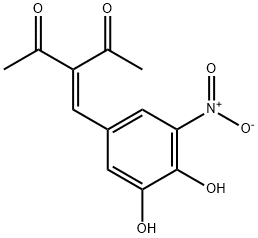Catechol-O-methyltransferase (COMT) plays an important role in normal brain function and has been implicated in human disorders, such as Parkinson's disease, as it is key to the degradation of catecholamines including dopamine, epinephrine, and norepinephrine. There are two classes of COMT, the soluble cytosolic form (S-COMT) and the rough endoplasmic reticulum membrane bound form (MB-COMT). Nitecapone is a reversible S-COMT inhibitor with IC50 values of 300 nM (Ki = 23 nM) in rat liver and 20 nM in brain tissues ex vivo. It is selective for COMT, inhibiting tyrosine hydroxylase, dopamine-β-hydroxylase, DOPA decarboxylase, and monoamine oxidase-A/B with IC50 values in the micromolar range. In rats, oral administration of 3–30 mg/kg nitecapone in combination with L-DOPA and carbidopa has been shown to reduce 3-O-methyl-dopa (3-OMD) formation and to elevate both serum and brain L-DOPA, dopamine, and DOPAC levels despite its poor ability to penetrate the blood-brain barrier. In clinical PET scan studies, nitecapone is reported to increase activity of the striatum by 22% in both normal volunteers and Parkinson’s disease patients. Additionally, this compound has been shown to increase mechanical and thermal nociception, and to reduce neuropathic pain in diabetic rats and in a spinal nerve ligation model. At high micromolar to millimolar concentrations in in vitro research studies, nitecapone is also known to be an effective antioxidant, nitric oxide radical scavenger, and iron chelator that can protect cells from lipid peroxidation.

